Who Are the Orangemen and What Is the Orange Order?

July 12th, more commonly known as ‘The Twelfth’, is an important day in the Northern Irish calendar. A public holiday, it celebrates the victory of Protestant King William of Orange over Catholic King James II during the Glorious Revolution. More specifically, it commemorates the Battle of the Boyne, a tipping point in the war that led to the continuation of the Protestant Ascendancy. Every year, the Orange Order marks the day by organising parades and bonfires. But just who are the Orangemen and what is the Orange Order?
History
The Orange Order, also known as The Loyal Orange Institution, was founded in 1795, sworn to uphold the ideals of the Protestant Ascendancy. Nowadays, the Order’s commitment to British Unionist ideals is more relevant, although membership is still closed off to non-Protestants. The Order has always been political, as a conservative Unionist organisation with ties to two of Northern Ireland’s largest parties. In the past, they had been associated solely with the Ulster Unionist Party, the UUP, but in recent years, members of the Orange Order have tended to vote for the Democratic Unionist Party, as they are opposed to the Good Friday Agreement.

Dress code
Because of their association with King William of Orange, the fraternity has taken orange as its signature colour. Why orange? Well, because King William was born in the Netherlands. Around The Twelfth, orange bunting goes up, and members of the order wear orange sashes in memory of ‘King Billy’. In Northern Ireland, orange as a colour is inseparable from its political connotations.

The Eleventh Night
The Twelfth is by far the largest event celebrated by the Orange Order, and so it should come as no surprise that there are also a lot of smaller events surrounding the day. In the weeks running up to the main parade, local Orange Lodges around the country hold smaller parades in their towns. Protestant and unionist areas decorate their streets with flags and bunting, and occasionally, kerbstones are painted red, white, and blue as a tribute to the Union Flag. The night before The Twelfth is traditionally marked by bonfires, with different communities competing to see who can build the biggest, with some reaching over 100 feet (30.4 metres) in height.

Controversy
Unfortunately, The Twelfth is not always a peaceful time. Aside from the safety concerns caused by The Eleventh Night bonfires, people also often burn Irish flags during this event, along with effigies of Irish nationalist politicians. Catholic and nationalist citizens see this as inflammatory, often disapproving of the bonfires and marches. Orange parades will also often pass through nationalist areas on their marches, and violence is not unheard of. As a result, there is a continued police presence at Twelfth celebrations across the country. However, in recent years, there has been an effort to present The Twelfth as a family-friendly event and tourist attraction. The Twelfth of 2016 was the most peaceful in many years, and we can only hope that these attempts to make peace are paying off.














